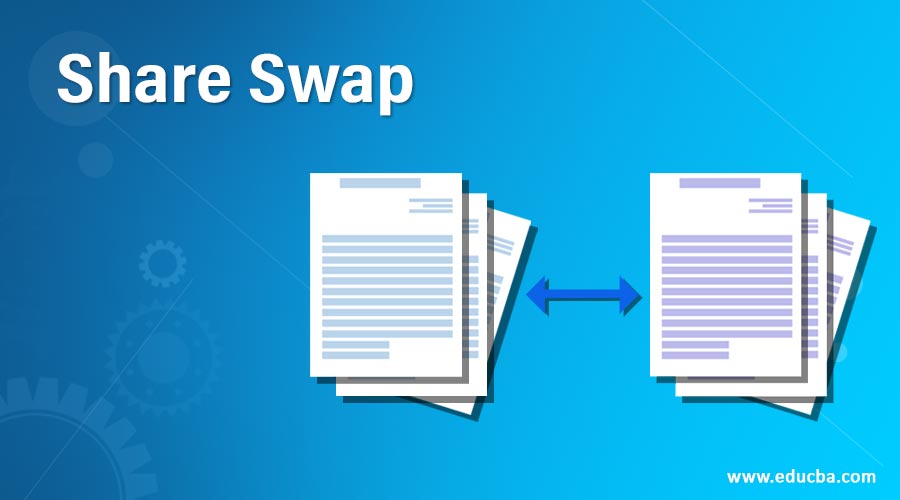Updated July 21, 2023
What is Share Swap?
The term “share swap” refers to the corporate arrangement, in case of a merger or acquisition, under which two entities agree to exchange the equity-based asset of one with that of the another.
It is also popularly known as a share-for-share exchange, share exchange, stock-for-stock. During a merger or acquisition, the acquiring company offers its own shares to the shareholders of the target company at a predetermined rate that has been derived as per the fair swap ratio or exchange ratio.
Explanation for Share Swap
It refers to the situation wherein the ownership of the shares in the target company are converted into the ownership of the shares in the acquiring company as per a pre-defined swap ratio. Please note that, during a share swap, the accurate valuation of both the combining entities is very important for arriving at a fair swap ratio. In case of any merger or acquisition deal, share swap may constitute the entire part of the deal or it may constitute a portion the deal along with other arrangements, primarily cash transactions,
How Does Share Swap Work?
Now, let us have a look at a fictitious company to understand how exactly it works.
- Let us assume Company A wants to acquire a rival entity, Company B, in a share swap arrangement. So, Company A is the acquirer, and Company B is the target.
- Next, Company A agrees to give a certain number of its own shares to the shareholder’s Company B in exchange for each Company B share.
- Next, let us assume that the swap ratio is 2-for-1. So, a shareholder with 100 Company B shares would end up with 200 Company A shares.
- Finally, after the successful conversion, the shares of Company B would cease to exist.
At times, the target companies that intend to avoid the acquisition tend to use the share swap as a strategy to resist the takeover. In this way, the target companies can garner better terms by claiming that the existing terms are not favorable. Further, the new shareholders are not allowed to sell the shares immediately after the share swap.
Examples of Share Swap
Let us have a look at some of the major examples:
- In the year 2010, Mirant Corporation and RRI Energy Inc. agreed to join hands to form the new entity – GenOn Energy, one of the largest independent power producers in the US. As per the definitive agreement, for each share of Mirant, the shareholders were offered 2.835 shares of RRI.
- This share swaps arrangement was too attractive for the shareholders and board members of Mirant, who were eventually convinced to allow the takeover that was completed in December 2010.
- In the year 2014, Daum Communications and Kakao Corp entered into a definitive agreement to merge in a share swap deal to form Daum Kakao, one of South Korea’s Largest Internet Companies. The swap ratio for the merger was approximately 1:1.556.
- In the year 2017, Disney and 21st Century Fox decided to merge in an all-stock deal that was worth $52 Billion. As per the definitive agreement, 21st Century Fox would own 25% of the newly formed entity, while Disney would own the remaining 75%. Further, as per the terms of the agreement, for each share of 21st Century Fox, the shareholders were offered 0.2745 shares of Disney.
Benefits
Some of the major benefits are as follows:
- One of the biggest benefits of a share swap is that it restricts the extent of cash transactions in mergers and acquisitions. Even the companies that are sitting on a pile of cash find it difficult to invest such a huge amount of cash in the execution of the transactions. So, a no-cash deal arrangement of share swap fits perfectly in such a situation.
- Its also means a limited requirement of financial support, which in turn results in savings in terms of borrowing costs. For companies that are low on cash reserve, share swap can be seen as a boon as it helps them merge by leveraging their market value.
- Given that the share swap mechanism results in a lower cash transaction, it happens to attract lower tax liability and less attention in the eyes of the regulators who otherwise scrutinize these deals very minutely.
Limitations
Some of the major limitations are as follows:
- At times the share swap arrangement might act against the target companies in case of hostile takeovers. If the acquiring company is able to influence the majority of the voters in the target company, they can easily acquire the shares of the target company without any extra cash in the form of the share swap. A such, some economists criticize share swap mechanism as they believe it to be more capitalist friendly.
- The sole idea behind a merger or acquisition is the inherent synergy between the combining entities and share swap can be a risk to that. In some cases, the newly formed entity might become too big to sustain or might end cannibalizing into each other’s market share. The merger might also fail due to dissatisfaction among the workforce owing to contrasting work cultures.
Conclusion
So, it can be seen that share swap can be used by cash-rich companies for hostile takeovers of the target companies or by companies that seek to combine through mutual agreement to leverage each other’s market value. In either case, the target companies are attractive because of their ability to generate profit but lack management intent to grow. So, the share swap mechanism can be used to extract benefits that can’t be envisaged in the absence of this miraculous mechanism.
Recommended Articles
This is a guide to Share Swap. Here we also discuss the introduction to sharp Swap, how does it work along with benefits and limitations. You may also have a look at the following articles to learn more –



